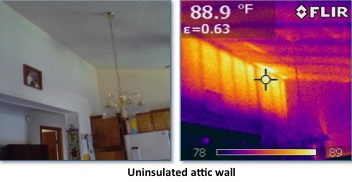No products in the cart.
Thermal Imaging Enhances Energy Audits
Before a problem can be fixed, it must be properly diagnosed. Treating symptoms without investigating the cause can be a risky proposition. Just as a doctor wouldn’t treat pain without considering the whole person to diagnose the cause, an energy auditor must perform diagnostics based on the house as a system.
When evaluating a home’s performance and level of energy efficiency, a first line of defense is to determine where energy is being lost. It’s important to identify the “energy vampires” that are sucking energy from the home. Zeroing in on energy wasters can be the key to improving a home’s performance.
While not required for all energy audits, thermal imaging is one the most technologically advanced diagnostic tools available to the energy auditor.
What is Thermal Imaging? Thermal imaging, also called thermography, is the means by which infrared light is made visible to the human eye. Infrared light is electromagnetic radiation with longer wavelengths than visible light. The highly specialized science of thermal imaging allows humans to see and interpret heat energy that could not otherwise be seen with the naked eye. To oversimplify, thermal imaging technology creates images to represent temperature variations.

What Can An IR Camera Detect? One of the myths surrounding thermal imaging is that the camera sees through walls. This is not the case. The image that is generated indicates breaks in the building’s thermal envelope, such as a hole in the roof, missing insulation, etc. Even without actual “x-ray vision,” an infrared camera has proven to be a useful tool in evaluating what is within the walls of a home.
Thermal images can indicate if a building needs insulation and where it should go, based on surface temperature variations.
Thermal imaging can be used to detect heat loss and air leakage in a building envelope. When possible, it may be used in conjunction with a blower door test that exaggerates the leakage of air through any defects in the building shell.
Underlying moisture and condensation in plumbing, HVAC systems, and roofing can be located. Because wet materials conduct heat faster than dry materials, thermography is effective at detecting troublesome water leaks and accumulation of moisture.
Abnormally hot electrical connections or energy leaks in electrical panels can be detected.
What Are The Benefits? Many problems begin with an increase in temperature, and the IR camera allows for early detection of these potential problems that might otherwise go unnoticed. Thermal imaging allows inspections to be conducted more efficiently, without disrupting any surfaces, equipment, or barriers.
Are you interested in energy auditing and the specialized equipment used to detect problems that impact home performance? Check out Everblue’s Energy Auditor courses, and learn more about using technology to improve the energy efficiency of buildings.
